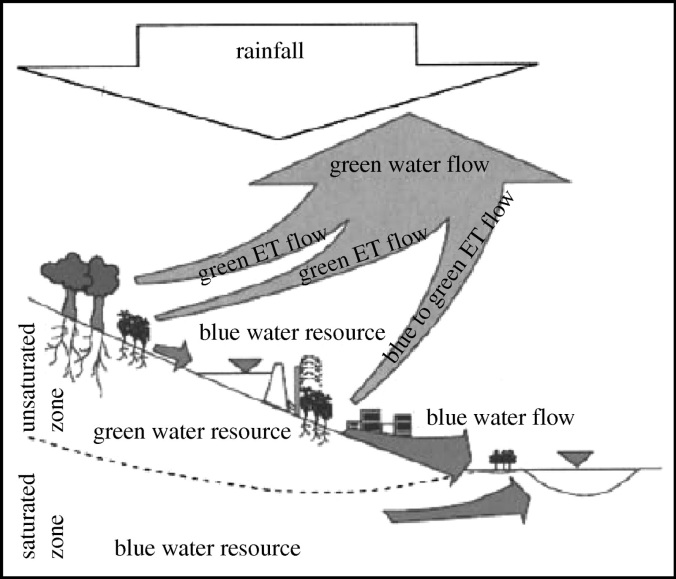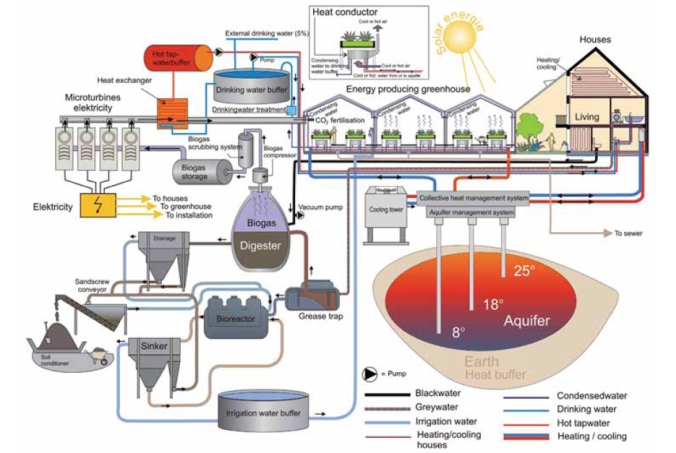Originally published on Tangible Virtual Water on 04/12/2016.
Water is available on Earth in various forms and sources: oceans, lakes, rivers and streams, snow, glaciers, precipitation, fog, wetlands, underground aquifers…
This post is an opportunity to investigate a little, and clarify the terminology which categorises different types of water and virtual water, to understand how they are affected from human use.
Part of the range of terms attributed to water are divided in colours which somewhat reflect the state of the water in question and are typically attributed to different sources, kinds and uses.
These are: blue, green, grey and black water.
Blue water
Rockström et al. refer to blue water as liquid water in rivers and aquifers, in addition to groundwater, as considered by Hoekstra et al., and lakes and dams, according to Falkenmark et al.
Green Water
Rockström et al. explain green water is “naturally infiltrated rain, attached to soil particles and accessible to roots”.
Blue and green water are closely linked in two ways, mainly: the moisture present in the soil percolates restoring the underlying aquifer, and blue water can be used to supply the lack of green water through irrigation (Rockström et al.)
There are two water complementary flows: the blue water flow through rivers, wetlands and underlying aquifers or groundwater and the green vapour water.
The green water flow is from natural systems (crops, forests…), it evaporates back into the atmosphere and comes back in form of precipitation.
The cycle can then start again.
Grey Water
Jefferson et al. define grey water as arising “from domestic washing operations. As such sources include waste from hand basins, kitchen sinks and washing machines, but specifically exclude foul or black water sources (toilet, bidets and urinals).” […] usually generated by the use of soap or soap products for body washing and as such, varies in quality according to, amongst other things, geographical location, demographics and level of occupancy.”
Grey water is collected from sinks, showers, baths, washing machines, dishwashers and can be distributed with different means, such as distribution of water directly from the sink into the toilet as flushing water, or by treating it and making it suitable for irrigation.
In addition, grey water as its own footprint, which the water footprint website defines as “The volume of freshwater that is required to assimilate the load of pollutants based on natural background concentrations and existing ambient water quality standards. It is calculated as the volume of water that is required to dilute pollutants to such an extent that the quality of the water remains above agreed water quality standards.”
Black Water
Black water is water which has come into contact with fecal matter, which contains harmful bacteria and pathogens.
Unlike grey water, coming into contact with this type of waste means that the water is not able to be reused, for example in irrigation, without the risk of contamination.
Waste water has its quality affected due to human use, from domestic use (grey and black water) to industrial or commercial production.
As mentioned before, we are living within the context of a water crisis: using as little water and as efficiently as possible is vital.
Water-efficient solutions are available and at times in place.
The image below is an example of a greenhouse village which shows the potential of what can be achieved already.
It is decentralised from an energy and water supply and with a waste and water treatment. This means it is an independent, closed loop system where there is no waste or entropy: everything is a valuable input.
Water is supplied by collecting rain water and is kept in a cycle by treating grey water from the home, which is used for irrigating the greenhouse, itself is a source of energy; black water waste gets treated too and provides soil conditioner.
This introduction to different types of water will be useful when I delve into the cost of meat, in my upcoming post.
In the meantime, more information on types of water, water footprint, virtual water and more and can be found from the water footprint website.
How do you manage your home’s water use?
Do you know of other ways to minimise water loss?

